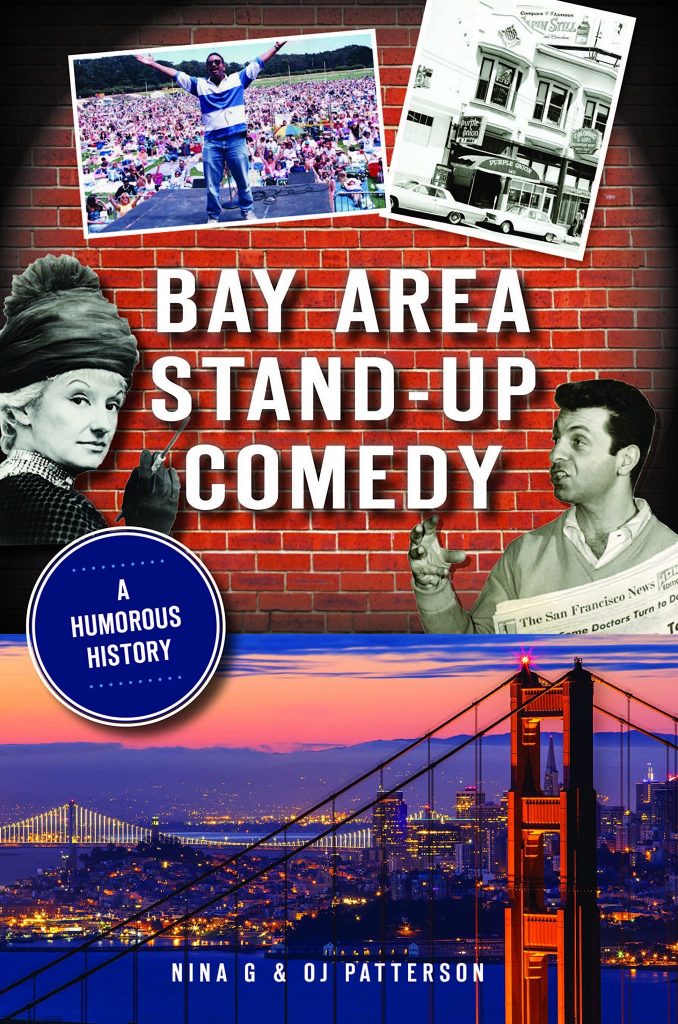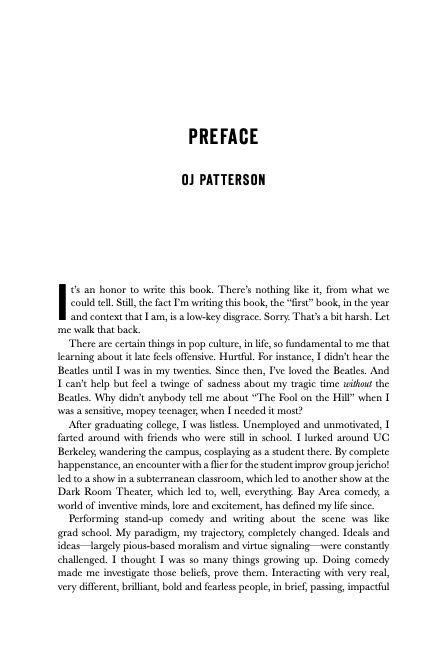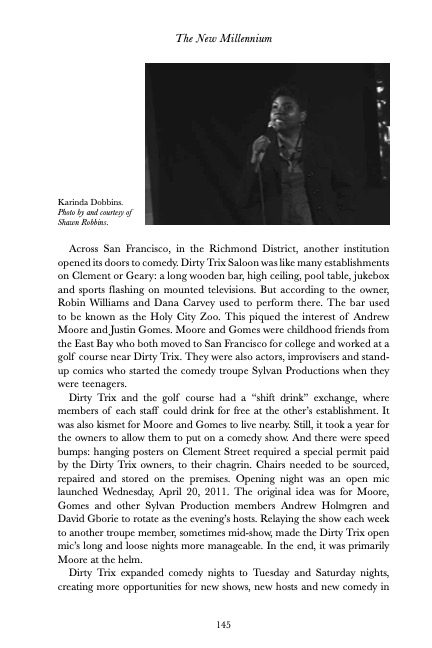Origins
December 2020, peak COVID-era, pre-vaccine, we all took stock of what was important. We reached out to friends and relatives at a higher rate. New hobbies and projects were a priority. It was the perfect time to ask questions previously unexamined in the hustle and bustle of the previous paradigm. What is this? Why is that?
One question, inspired by a chat with comedy legend Marga Gomez about the Valencia Rose and Josie’s Juice Joint, made Nina wonder, “why isn’t there a history book about San Francisco Bay Area comedy?”
There was certainly enough information out there to write a book. San Francisco’s history with comedy is understated but understood to be substantial by those who know it. Numerous biographies, memoirs, newspaper articles and podcasts have detailed the impact the area has had on comedy at large. You can name luminaries from the scene, natives with impressive resumes, including Robin Williams, Dana Carvey, Mark Curry, and Ali Wong to name a few, until you’re blue in the face. So… why aren’t those irrefutable and fascinating facts collected and readily available?
After asking those questions to herself, Nina then wondered, “Well, why not me? Why don’t I write about SF comedy?” Nina had already written two books at that point. She some publishers. Nina knows and is fascinated by comedy in a sincere way. And then she thought, “what about OJ?”
Comedy Nerds
Nina and I talked about comedy constantly at open mike’s, in coffee houses, and at her house. We’re comedy nerds. More importantly, we’re SF comedy nerds. Nina lived her SF comedy nerdom early, as a child, listening to the Alex Bennett show, a local radio show that featured and promoted SF comedy, going to comedy clubs with her parents. I came in later, in time and at a later age, writing about all the comedy I experienced in my early 20s in this very blog.
I was “down”. Nina didn’t even have to ask before I said yes. This was the project I’ve worked on for 12 years in some way or another. It was an honor and a duty. We started researching before getting the greenlight. It was exciting and nerve-wrecking. We already had a timeline by the time our pitch was approved by Arcadia Publishing.
The pandemic meant “time.” It was a demarcation point like “B.C.” and “A.D.” There is no going back. But, to write the book, we had to look back to move forward. So with the end point fixed, Nina G and I found out the beginning, and worked for a year to illustrate the in between.
Bay Area Stand-Up Comedy: A Humorous History is Out
And the book is good. It doesn’t have everything but it has a lot. It was important for us to distinguish the book is “A” history, not “The” history. “The” history of Bay Area SF comedy would take three or four times the pages, a fact checker, a dedicated editor and an army of lawyers. We didn’t have all that. We had each other, some helpful friends, a few very funny comedians, some gracious photographers, some invaluable historical resources, the Internet Database, a team to check in with, a publisher with a process to get the book out there, and 150 years of history. The book paints San Francisco Bay Area stand-up comedy in broad, beautiful strokes. It reads well, looks good, feels great. You should get it.
Buy the book at Books on B in Hayward. They ship everywhere and have autographed copies. It’s available elsewhere but that’s up to you and God.
Here’s my part of the forward and a page of the book to whet your appetite.
Preface by OJ Patterson
It’s an honor to write this book. There’s nothing like it, from what we could tell. Still, the fact I’m writing this book, the “first” book, in the year and context that I am, is a low-key disgrace. Sorry. That’s a bit harsh. Let me walk that back.
There are certain things in pop culture, in life, so fundamental to me that learning about it late feels offensive. Hurtful. For instance, I didn’t hear The Beatles until I was in my 20s. Since then I’ve loved The Beatles. And I can’t help but feel a twinge of sadness about my tragic time without The Beatles. Why didn’t anybody tell me about “The Fool on the Hill” when I was a teen, when I needed it most?
After graduating college, I was listless. Unemployed and unmotivated, I farted around with friends who were still in school, at UC Berkeley, wandered the campus, cosplayed being a student there. By complete happenstance, an encounter with a flier for the student improv group jericho! led to a show in a subterranean classroom, which led to another show at the Dark Room Theater, which led to, well, everything. Bay Area comedy, a world of inventive minds, lore and excitement, has defined my life since.
Performing stand-up comedy and writing about the scene was like grad school. My paradigm, my trajectory, completely changed. Ideals and ideas—largely pious-based moralism and virtue signaling—were constantly challenged. I thought I was so many things growing up. Doing comedy made me investigate those beliefs, prove them. Interacting with very real, very different, brilliant, bold and fearless people, in brief, passing, impactful engagements, helped reveal the person I want to be and also the person I really am. It was an education of growth and loss in every way imaginable. I found good friends, new heroes, my tribe, my language. I met my wife in the process. I owe a lot to my time telling jokes. Bay Area comedy is life. For a time it was my life. Sometimes it still is.
So, learning about Bay Area comedy relatively late in life, as a young adult, feels like a betrayal. A low-key disgrace.
I’m a second generation Bay Area person—my dad is from Missouri and my mom is from North Carolina. Born in Hayward, raised all over, I have a personal anecdote about every BART station. By the age of 16 I knew the pros and cons of every arthouse theater in the 925, the 510, the 415 (and how to get there on the bus). My coming of age was defined by an unlimited desire to know, learn, search and seek art, culture and novel experiences in “The City”, “The Town” and beyond).
I’m a second generation comedy fan—my dad loved Richard Pryor and my mom loved Paul Mooney. Comedy was my connection to the outside world, how I learned about different cultures and understood the experiences of others. Half hour specials on Friday were a constant. Runteldat and The Original Kings of Comedy were essential movie theater experiences. I made mixtape CDs with clips of television shows, recorded proto-podcasts with childhood friends, took road trips to television tapings and comedy clubs, wrote jokes in cafes with college classmates. Funny was everything.
If ever there was an adolescent who needed to know about the likes of Warren Thomas or that SF Sketchfest was happening nearby, it was me. In theory, I could have watched Zach Galifianakis: Live at the Purple Onion, the special that made me want to do stand-up, actually live at the Purple Onion. Why didn’t somebody put “Bay Area” and “stand-up comedy” together for me, and let me know San Francisco was the place for that? Why didn’t I look into Bay Area comedy, or think to look into it, for myself?
It’s no one’s “fault,” really. Stand-up comedy often lives in the margins of society, a shadow dimension. It’s opaque, sometimes intimidating. Most people won’t know about the developing comedy talent in their hometowns until days, weeks, and years later, if at all. And comedy that happened decades ago? Forget about it! You have to be a super comedy nerd to even look that stuff up. You had to be active in that era to have evidence of those long past laughs (or to know where to find it).
That’s why Nina and I became friends. It’s what led to this book. To find someone with a similar obsession about comedy, especially Bay Area comedy, is a rare and treasured connection.
One could argue that everything happened for a reason. The age I found SF comedy was without barriers or permission; comedy venues are largely limited for minors. Being an adult meant I didn’t have to ask for permission. Comedy quickly became “my thing”. And it was probably more impactful “how” I made it mine.
Never thought I could do stand-up until I saw it as an adult in my hometown. Never thought to research and write about it until after I started performing. As I dug I kept finding out about AMAZING, seemingly obscure facts and connections to the people I met and places I performed. In a city full of transplants and trailblazers, natives and those passing through, a consistent, organic, undeniable tradition to foster great comedy has always persisted.
The timing of my induction was also advantageous. In addition to giving access to numerous newspapers and databases, the Internet democratized people’s ability to share their memories, their stories. A podcast here. A Facebook post there. An abandoned MySpace page with a trove of candid pictures. So many memoirs! Not enough biographies!
Bay Area comedy history is full of special artists who recognized their time, their era, was also special. Preserving that specificity is a scattered, personal, often thankless task. But their contributions, officially and unofficially, were invaluable to this book (and my life).
Hopefully this won’t be the only collection of San Francisco Bay Area comedy history published. That would be sad. We couldn’t get to everything. I don’t think one book can. Respectful apologies to all the sketch and improv fans and performers. The Committee, Spaghetti Jam, Femprov, Bindlestiff Studio, BATS Improv, Endgames Improv, Killing My Lobster, Culture Clash and so many others deserve more time and attention than we were able to give (this time). I hope there will be many books that celebrate all the uniquely talented, funny folk that the Bay has nurtured.
And not just books, I hope knowledge about Bay Area comedy takes every form imaginable. I hope there’s a comedy museum in North Beach or Oakland one day, an Airstream trailer full of memorabilia to tour to local junior high and high schools. I hope that people living in the Bay Area who love humor, or anyone that’s interested in the “San Francisco Bay Area” and “stand-up comedy,” find more answers than questions after reading this book. Or, at least, I hope they ask different, better questions about the artform, lifestyle and subculture; I hope they dig deeper. I hope people are encouraged to go to a show or to start doing comedy themselves. I hope this helps.
Excerpt from “The New Millenium”, Bay Area Stand-Up Comedy: A Humorous History by Nina G and OJ Patterson
Across San Francisco, in the Richmond District, another institution opened its doors to comedy. Dirty Trix Saloon was like many establishments on Clement or Geary: a long wooden bar, high ceiling, pool table, jukebox and sports flashing on mounted televisions. But according to the owner, Robin Williams and Dana Carvey used to perform there. The bar used to be known as the Holy City Zoo. This piqued the interest of Andrew Moore and Justin Gomes. Moore and Gomes were childhood friends from the East Bay who both moved to San Francisco for college and worked at a golf course near Dirty Trix. They were also actors, improvisers and stand- up comics who started the comedy troupe Sylvan Productions when they were teenagers.
Dirty Trix and the golf course had a “shift drink” exchange, where members of each staff could drink for free at the other’s establishment. It was also kismet for Moore and Gomes to live nearby. Still, it took a year for the owners to allow them to put on a comedy show. And there were speed bumps: hanging posters on Clement Street required a special permit paid by the Dirty Trix owners, to their chagrin. Chairs needed to be sourced, repaired and stored on the premises. Opening night was an open mic launched Wednesday, April 20, 2011. The original idea was for Moore, Gomes and other Sylvan Production members Andrew Holmgren and David Gborie to rotate as the evening’s hosts. Relaying the show each week to another troupe member, sometimes mid-show, made the Dirty Trix open mic’s long and loose nights more manageable. In the end, it was primarily Moore at the helm.
Dirty Trix expanded comedy nights to Tuesday and Saturday nights, creating more opportunities for new shows, new hosts and new comedy in the historic space.



